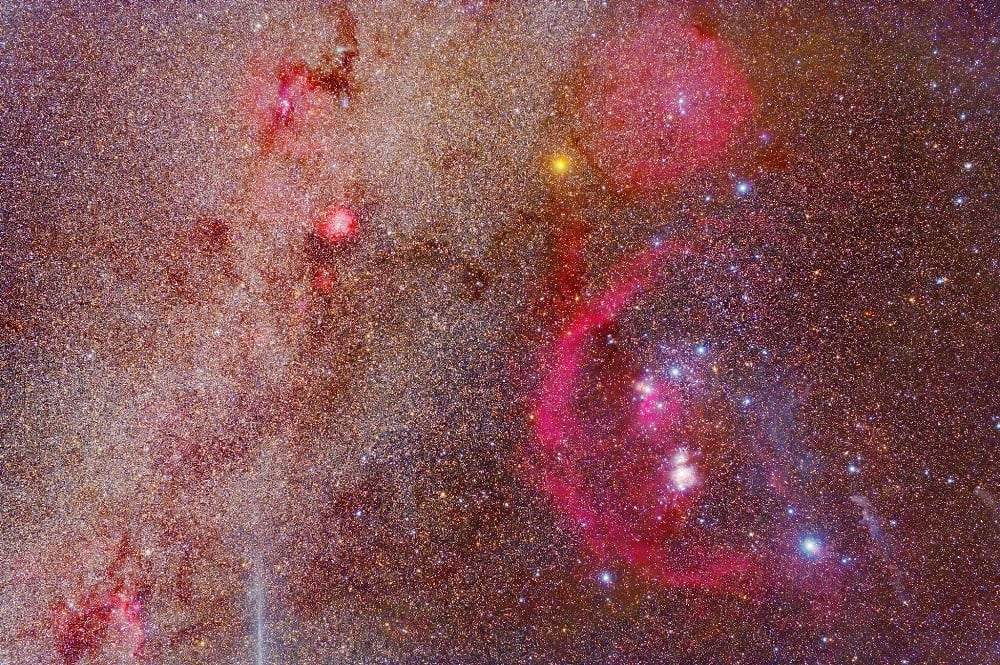Ready for one more? While all eyes are still following
Comet 21/P Giacobini-Zinner
as it glides through northern hemisphere skies, we'd like to turn your attention towards another icy interloper: periodic
Comet 38P Stephan-Oterma
.
[caption id="attachment_140162" align="alignnone" width="580"]
A zoom-in on Comet 38P from the introduction image. Credit Hisayoshi Kato[/caption]
On a 37.7 year orbit, Comet 38P Stephan-Oterma last reached perihelion on December 5
th
, 1980. The comet ranges from a perihelion of 1.57 Astronomical Units (AU) just outside of the orbit of Mars, to an aphelion of 20.9 AU, near the orbit of Uranus. In fact, if 38P
wasn't
a comet, it would fall into the class of Centaur-like asteroids.
[caption id="attachment_140164" align="alignnone" width="580"]
The orbit of Comet 38P through the inner solar system. Credit: NASA/JPL[/caption]
A short-period comet comet (the "P" designation at the front of the comet's name) is simply a comet with an orbital period shorter than 200 years. The first comet on the list 1/P Halley is the most famous of them all, and 2/P Encke has the shortest known orbital period for a comet, at just over three years. 374 short period comets are known thus far.
The
Comet that would become 38P
was first noticed by J
è
ro
me Eug
è
ne Coggia on the night of January 23
rd
, 1867 observing from the Marseilles Observatory in France using an 80-cm reflecting telescope. Unfortunately, Coggia misidentified the faint smudge as an uncatalogued nebula, and missed the discovery. On the next clear evening, astronomer E.J.M. Stephan also at Marseilles noted the same smudge had moved into the constellation Aries.
Why the name? Well, the comet would remain lost for nearly a century, until Finnish astronomer Liisi Oterma recovered it as a +13
th
magnitude smudge on the night of November 6
th
, 1942.
The 2018 apparition of
Comet 38P
is one of two close approaches of the comet to the Earth for the 21
st
century, and won't be topped until November 3rd, 2056 at 0.7 AU distant. The last close pass was 0.63 AU on December 7th, 1942.
[caption id="attachment_140165" align="alignnone" width="580"]
The celestial path of comet 38P through the end of 2018. Credit: Starry Night.[/caption]
Comet 38P: A Blow by Blow for 2018
Unfortunately, Comet 38P won't attain a brightness of higher than
+8 to +9 magnitude
(unless of course, it undergoes a wildcard outburst). The comet spends the first half of October as an early morning object in Orion, before vaulting up through Gemini into the Lynx and becoming a late night object. Comet 38P should remain well placed for northern hemisphere observers through to New Year's Day 2019, when the comet may drop back down below binocular visibility at +10
th
magnitude.
Here are some key dates to watch for:
October
6- Passes near (less than one degree) the +4.4 magnitude star Chi Orionis.
10-Crosses the galactic plane northward.
11-Crosses into the astronomical constellation of Gemini.
16-Passes near (less than one degree) the +1.9 magnitude star Alhena.
30-The waning gibbous Moon passes 2 degrees north of the comet.
[caption id="attachment_140166" align="alignnone" width="580"]
Comet 39P passes near the Eskimo nebula. Credit: Starry Night.[/caption]
November
7-Photo-op: passes 20' from the Eskimo Nebula NGC 2392.
7-Reaches perihelion, at 1.577 AU from the Sun.
11-Crosses the ecliptic plane northward.
23-Crosses into the astronomical constellation of Cancer
[caption id="attachment_140167" align="alignnone" width="580"]
The projected and observed light curve of comet 38P. Credit:
Seiichi Yoshida.
[/caption]
December
12-Crosses into the constellation of the Lynx.
18- Passes closest to the Earth, at 0.771 AU distant.
January
1- Drops back down below +10
th
magnitude?
At above +10
th
magnitude for the next few weeks, you should be able to spot Comet 38P with binoculars under dark skies, though of course, a telescope with a generous field of view will help. Start by sweeping the suspect star field, looking for that one tiny fuzzball that refuses to snap into focus. Follow that fuzzball for a few hours or more, and you'll see the tell tale movements of a comet.
Good luck, and clear skies!
Read all about observing and discovering comets in our new book,
The Universe Today Ultimate Guide to Observing the Cosmos
, out on October 23
rd
, now up for
pre-order
.
 Universe Today
Universe Today
